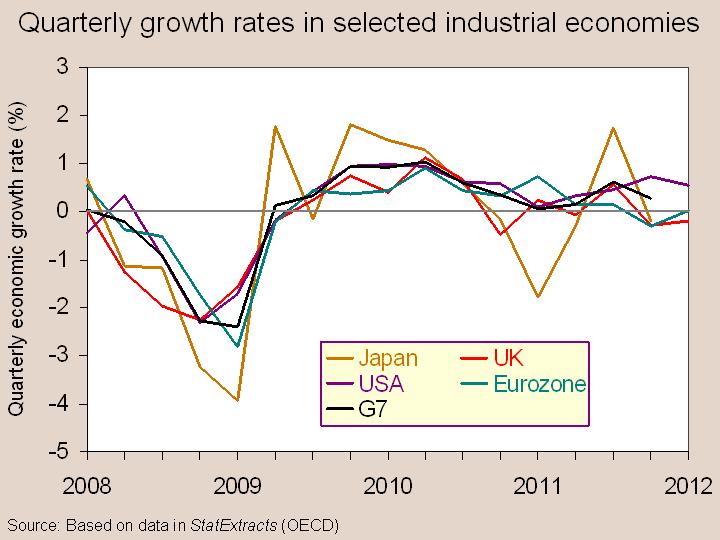 With talks ongoing about resolving the Greek debt crisis, it is clear that there is no agreement that will satisfy both sides – the Greek government and the troika of lenders (the IMF, the ECB and the European Commission). Their current negotiating positions are irreconcilable. What is needed is something more fundamental to provide a long-term solution. What is needed is a ‘deus ex machina‘.
With talks ongoing about resolving the Greek debt crisis, it is clear that there is no agreement that will satisfy both sides – the Greek government and the troika of lenders (the IMF, the ECB and the European Commission). Their current negotiating positions are irreconcilable. What is needed is something more fundamental to provide a long-term solution. What is needed is a ‘deus ex machina‘.
A deus ex machina, which is Latin for ‘god from a machine’, was a device used in Greek tragedy to solve an impossible situation. A god would appear from above, lowered by a crane, or from below through a trap door, and would put everything right. The tragedy would then be given a happy ending.
So what possible happy ending could be brought to the current Greek tragedy and who could be the deus ex machina?
 The negotiations between Greece and the troika currently centre on extending credit by €7.2bn when existing debts come up for repayment. There are repayments currently due to the IMF, or by the end of June, of €1.5bn and more in July, September and December (another €3.2bn). There are also €6.7bn of Greek bonds held by the ECB, as part of the 2010 bailout programme, that are due for repayment in July and August. Without the €7.2 billion bailout, Greece will be unable to meet these debt repayments, which also include Treasury bills.
The negotiations between Greece and the troika currently centre on extending credit by €7.2bn when existing debts come up for repayment. There are repayments currently due to the IMF, or by the end of June, of €1.5bn and more in July, September and December (another €3.2bn). There are also €6.7bn of Greek bonds held by the ECB, as part of the 2010 bailout programme, that are due for repayment in July and August. Without the €7.2 billion bailout, Greece will be unable to meet these debt repayments, which also include Treasury bills.
But the troika will only release the funds in return for harsh austerity measures, which involve further cuts to pensions and public expenditure. Greece would be required to run a substantial budget surplus for many years.
Greece could refuse, but then it would end up defaulting on debt and be forced out of the euro. The result would probably be a substantial depreciation of a newly restored drachma, rising inflation and many Greeks suffering even greater hardship – at least for a period of time.
 So what is the possible deus ex machina? If you’re looking for a ‘god’ then it is best, perhaps, to look beyond the current actors. Perhaps the Americans could play the role in finding a solution to the impasse. Perhaps a small group of independent experts or politicians, or both, could find one. In either case, the politics of the situation would have to be addressed as well as the economics and finance.
So what is the possible deus ex machina? If you’re looking for a ‘god’ then it is best, perhaps, to look beyond the current actors. Perhaps the Americans could play the role in finding a solution to the impasse. Perhaps a small group of independent experts or politicians, or both, could find one. In either case, the politics of the situation would have to be addressed as well as the economics and finance.
And what would be the ‘fix’ to satisfy both sides? Ultimately, this has to allow Greek debt to be sustainable without further depressing demand and undermining the fabric of Greek society.  This would almost certainly have to involve a large measure of debt forgiveness (i.e. debts being written off). It also has to avoid creating a moral hazard, whereby if the Greeks are seen as being ‘let off lightly’, this might encourage other indebted eurozone countries to be less willing to reduce their debts and make demands for forgiveness too.
This would almost certainly have to involve a large measure of debt forgiveness (i.e. debts being written off). It also has to avoid creating a moral hazard, whereby if the Greeks are seen as being ‘let off lightly’, this might encourage other indebted eurozone countries to be less willing to reduce their debts and make demands for forgiveness too.
Ultimately, the issue is a political one, not an economic one. This will require clever negotiation and, if there is a deus ex machina, clever mediation too.
Videos
 Greek PM Tsipras warns lenders bailout plans ‘not realistic’ BBC News, Jim Reynolds (5/6/25)
Greek PM Tsipras warns lenders bailout plans ‘not realistic’ BBC News, Jim Reynolds (5/6/25)
 Greece defers IMF payment until end of June BBC News, Chris Morris (5/6/15)
Greece defers IMF payment until end of June BBC News, Chris Morris (5/6/15)
 Greek debt talks: Empty shops and divided societies BBC News, Chris Morris (10/6/15)
Greek debt talks: Empty shops and divided societies BBC News, Chris Morris (10/6/15)
 Potential Grexit effects Deutsche Welle (13/6/15)
Potential Grexit effects Deutsche Welle (13/6/15)
Articles
It’s time to end the pretence: Greece will never fully repay its bailout loan The Guardian, Andrew Farlow (9/6/15)
Greek exit would trigger eurozone collapse, says Alexis Tsipras The Guardian, Phillip Inman, Helena Smith and Graeme Wearden (9/6/15)
The eurozone was a dream of unity. Now Europe has turned upon itself The Guardian, Business leader (14/6/15)
Greece bailout talks: an intractable crisis with three possible outcomes The Guardian, Larry Elliott (2/6/15)
Greece needs an economic defibrillator and a debt write-off Financial Times letters, Ray Kinsella (25/3/15)
Greece’s new debt restructuring plan Times of Change, Peter Spiegel (5/6/15)
Eurozone still in denial about Greece BBC News, Robert Peston (3/6/15)
Greece bailout talks – the main actors in a modern-day epic The Guardian, Phillip Inman, Ian Traynor and Helena Smith (9/6/15)
Greece isn’t any old troubled debtor BBC News, Robert Peston (15/6/15)
Greece in default if debt deadline missed, says Lagarde BBC News (18/6/15)
Burden of debt to IMF and European neighbours proves too much for Greece The Guardian, Heather Stewart (17/6/15)
Paper
Ending the Greek Crisis: Debt Management and Investment led Growth Greek government
Questions
- To which organisations is Greece indebted? What form to the debts take?
- To what extent is Greece’s current debt burden the result of design faults of the euro?
- Would it be possible to restructure debts in ways that make it easier for Greece to service them?
- Should Greece be treated by the IMF the same way it treated the highly indebted poor countries (HIPCs) and granted substantial debt relief?
- What would be the effects of Greek exit from the euro (a) for Greece; (b) for other eurozone countries?
- What bargaining chips can Greece deploy in the negotiations?
- Explain what is meant by ‘moral hazard’. Where in possible outcomes to the negotiations may there be moral hazard?
- What has been the impact of Greek austerity measures on the distribution of income and wealth in Greece?
- What are the practicalities of pursuing supply-side policies in Greece without further dampening aggregate demand?
 The expansion of the BRIC economies has both advantages and disadvantages for Western countries. Their consistently high growth rates have created a much wider market place for Western firms and a much needed additional source of consumer demand, especially in times of recession. Countries such as China have had double digit growth rates, with others like India experiencing growth rates of just under 10%. But are these impressive growth rates now beginning to fall?
The expansion of the BRIC economies has both advantages and disadvantages for Western countries. Their consistently high growth rates have created a much wider market place for Western firms and a much needed additional source of consumer demand, especially in times of recession. Countries such as China have had double digit growth rates, with others like India experiencing growth rates of just under 10%. But are these impressive growth rates now beginning to fall?
For the last 2 years, the growth rate in the Indian economy has been sub-5%, with growth in the 2013-14 financial year at 4.7%. Though some sectors, including agriculture have experienced buoyant growth, it is other sectors that have been holding this economy back. Manufacturing contracted at an annualised rate of 1.4% over the quarter, while mining contracted by 0.4%. With a growth rate of just under 5%, one might think that this was good – after all many Western economies have only recently entered positive growth. However, the Indian economy has a rapidly growing population and it is estimated that 10 million additional jobs each year must be created. It is this figure that requires such a high growth rate – estimated at around 8%. Thus, the sub-5% growth recorded for 2 years is insufficient to sustain the required job creation.

There are many factors that appear to be holding growth back. High inflation has been a problem for some years and the Indian currency has been relatively weak and volatile. Together, these issues have created an environment of uncertainty and if there’s one thing that investors don’t like, it’s uncertainty. This has therefore led to a lack of investment in the economy, which is a key component of aggregate demand and hence a key source of economic growth. Furthermore, interest rates rose last year, thereby pushing up the cost of borrowing and the rate of credit growth has also slowed. These factors collectively have led to lower foreign investment, domestic investment and spending, which have all contributed towards more subdued growth than in the past. Glenn Levine, a senior economist at Moody’s said:
India’s economy continues to grow well below potential as a combination of supply‐side constraints and the adverse effects of an underperforming government weigh on capital expenditure and hiring … It will be a while before the Indian economy is expanding above 6% again.
However, many economists remain optimistic about the prospects of Asia’s third-largest economy. Inflation appears to be under control and the currency has gained strength. Many believe that more investment supporting government policies will be the kick start the economy needs and this will in turn encourage firms to begin investment. It may be the new leader of this country, Narendra Modo, that will jump start the economy. The Prime Minister is expected to back policies to stimulate growth, who will direct more spending at infrastructure, simplify taxes and introduce policies to attract foreign investment. Adi Godrej, Chairman of the Godrej group said:
As soon as investors see the first signals of growth-supportive policies, you will see a definite turnaround on the ground.
The coming months will be crucial in determining how quickly the Indian economy is likely to see a return to near double digit growth. The new government has indeed promised policies to boost the economy, but the annual budget will confirm whether this promise is likely to be kept. Given the dependence of Indian jobs on a fast growth rate and the dependence of the Western world on the continued growth of the BRICs in creating a wider market for our exports, the fortunes of India are extremely important. The following articles consider this economy.
Indian economy grew at 4.7% in 2013-14 The Times of India (30/5/14)
India’s economic growth disappoints BBC News (30/5/14)
India’s GDP grows 4.7% in fiscal year, missing government forecast Wall Street Journal, Anant Vijay Kala (30/5/14)
India’s economy expands 4.7pct in fiscal year 2013/14 Reuters (30/5/14)
India’s economy still underwhelms CNN Money, Charles Riley, Alanna Petroff (30/5/14)
FY14 GDP growth at 4.7%; India sees worst slowdown in 25 years The Economic Times (30/5/14)
India growth below 5% adds pressure on Modi to spur investment Bloomberg, Unni Krishnan (30/5/14)
Jim Armitage: ‘Modinomics’ in India has helped growth, but not for all Independent, Jim Armitage (17/5/14)
Questions
- Using a diagram, explain how economic growth can be created through (a) demand-side measures and (b) supply-side measures.
- Why would higher interest rates reduce growth?
- Why does high inflation create uncertainty and what impact does this have on business investment?
- India has experienced a weak and volatile currency and this has contributed towards a lack of foreign investment and low growth. Using a diagram, explain why this could be the case.
- What sort of government policies would you recommend for the Indian economy if you had become the new Prime Minister and your primary objective was to boost economic growth?
- Why is the expansion of the BRIC economies, of which India is one, so important for Western economies?
 In the third and final part of this blog, we look at the G8 summit at Camp David on 18 and 19 May 2012. Ways of averting the deepening global economic crisis were top of the agenda.
In the third and final part of this blog, we look at the G8 summit at Camp David on 18 and 19 May 2012. Ways of averting the deepening global economic crisis were top of the agenda.
In terms of the global economy, the leaders agreed on three main things. The first was that they supported Greece remaining in the euro. According to the communiqué:
We agree on the importance of a strong and cohesive eurozone for global stability and recovery, and we affirm our interest in Greece remaining in the eurozone while respecting its commitments. We all have an interest in the success of specific measures to strengthen the resilience of the eurozone and growth in Europe
The second was a commitment to ‘fiscal responsibility’ and the clawing down of public-sector deficits.
We commit to fiscal responsibility and, in this context, we support sound and sustainable fiscal consolidation policies that take into account countries’ evolving economic conditions and underpin confidence and economic recovery.
 The third was commitment to boosting economic growth. (Click on chart for a larger image.) On the supply side this would be through measures to stimulate productivity. On the demand side this would be through policies to stimulate investment.
The third was commitment to boosting economic growth. (Click on chart for a larger image.) On the supply side this would be through measures to stimulate productivity. On the demand side this would be through policies to stimulate investment.
(For a PowerPoint of the chart, click on the following link: Quarterly Growth.)
To raise productivity and growth potential in our economies, we support structural reforms, and investments in education and in modern infrastructure, as appropriate. Investment initiatives can be financed using a range of mechanisms, including leveraging the private sector. Sound financial measures, to which we are committed, should build stronger systems over time while not choking off near-term credit growth. We commit to promote investment to underpin demand, including support for small businesses and public-private partnerships.
But the communiqué was short on details. How will fiscal consolidation be achieved? Does this mean a continuation of austerity measures? And if so, what will be the impact on aggregate demand? Or if fiscal consolidation is slowed down, what will be the impact on financial markets?
If a growth in investment is central to the policy, what will be the precise mechanisms to encourage it? Will they be enough to combat the deflationary effect on demand of the fiscal measures?
And how will productivity increases be achieved? What supply-side measures will be introduced? And will productivity increases be encouraged or discouraged by continuing austerity measures?
Lots of questions – questions raised by the articles below.
Articles
Capitalism at a crossroads Independent (19/5/12)
 Barack Obama warns eurozone to focus on jobs and growth The Telegraph (20/5/12)
Barack Obama warns eurozone to focus on jobs and growth The Telegraph (20/5/12)
G8 Summit: World leaders push for Greece to stay in the eurozone The Telegraph, Angela Monaghan (19/5/12)
Obama sees ’emerging consensus’ on crisis Sydney Morning Herald, Ben Feller and Jim Kuhnhenn (20/5/12)
G8 leaders tout economic growth, fiscal responsibility CNN (20/5/12)
G8 focuses on Eurozone Gulf News (20/5/12)
G8 leaders back Greece amid tensions France 24 (20/5/12)
G8 splits over stimulus versus austerity Financial TimesRichard McGregor and Kiran Stacey (19/5/12)
Cameron is consigning the UK to stagnation Financial Times, Martin Wolf (17/5/12)
Time to end ‘Camerkozy’ economics Financial Times, Ed Miliband (18/5/12)
Obama: Eurozone ‘must focus on jobs and growth’ BBC News (20/5/12)
World leaders back Greece, vow to combat financial turmoil Reuters, Jeff Mason and Laura MacInnis (19/5/12)
Germany isolated over euro crisis plan at G8 meeting in Camp David Guardian, Patrick Wintour (19/5/12)
G8 leaders end summit with pledge to keep Greece in eurozone Guardian, Ewen MacAskill (19/5/12)
G8 summit ends with few tangible results Xinhua, Sun Hao (20/5/12)
Final communiqué
Camp David DeclarationG8 (19/5/12)
Questions
- To what extent are economic growth and fiscal consolidation (a) compatible; (b) incompatible objectives? How might a Keynesian and a new classical economist respond to these questions?
- What supply-side measures could be introduced by the EU?
- Why might dangers of protectionism increase in the coming months?
- What would be the impact of a Greek default and exit from the eurozone on other eurozone economies?
- What monetary policy changes could be introduced by the eurozone governments and the ECB in order to ease the sovereign debt crisis of countries such as Grecce, Spain, Portugal, Italy and Ireland?
 After a marathon 13-hour session in Brussels, ending at 5am on 21 February, eurozone finance ministers agreed a second bailout for Greece. The aim was to lighten Greece’s debt burden and prevent the country being forced to default.
After a marathon 13-hour session in Brussels, ending at 5am on 21 February, eurozone finance ministers agreed a second bailout for Greece. The aim was to lighten Greece’s debt burden and prevent the country being forced to default.
Under the deal, Greece will have some €107bn of its debt written off. The main brunt of this will be borne by private creditors, who will see the value of their Greek bonds fall by 53.5% (some 70% in real terms). Old bonds will be swapped for ones with longer maturities and lower interest rates. In addition, Greece will be given further loans of more than €130bn through the EFSF on top of the €73bn already lent. The monies will be put in a special escrow account and can be used only to service the debt, not to finance general government expenditure.
In return, Greece must reduce its debt to GDP ratio from the current 160% to 120.5% by 2020. It must agree to continuing tight austerity measures and to significant supply-side reforms to reduce the size of the public sector and increase efficiency. Implementation of the measures would be overseen by an EU Task Force based in Greece.
But while governments in the EU and around the world are relieved that a deal has been finally agreed and that Greek default seems to have been averted – at least for the time being – the problems for Greece seem set to get worse. The further austerity measures will deepen the recession, now in its fifth year. Growth is not expected to return until 2014 at the earliest, by which point real GDP is expected to have shrunk by some 17% from the start of the recession. The question is whether the Greek people will stand for further cuts in income and further rises in unemployment, which had reached 20.9% in November 2011 and is still rising rapidly.
Articles
Eurozone backs Greek bailout Euronews (21/2/12)
Greece Wins Second Bailout as Europe Picks Aid Over Default Bloomberg, James G. Neuger and Jonathan Stearns (21/2/12)
Eurozone agrees second Greek bail-out Financial Times, Peter Spiegel and Alex Barker (21/2/12)
Greece secures bailout to avoid debt default Independent, Gabriele Steinhauser and Sarah DiLorenzo (21/2/12)
EU tells Greece to cut more jobs, sees 2014 growth Reuters, Gabriele Robin Emmott and Nicholas Vinocur (21/2/12)
Eurozone agrees €130bn bailout for Greece The Telegraph, Bruno Waterfield (21/2/12)
Greece averted nightmare scenario – finance minister BBC News (21/2/12)
Greece: Dangerous precedent? BBC News, Robert Peston (21/2/12)
The end of the marathon? The Economist, Charlemagne’s notebook (21/2/12)
What Analysts Think of the Greek Deal The Wall Street Journal, Alexandra Fletcher (21/2/12)
Three steps to a strong eurozone Guardian, Henning Meyer (21/2/12)
Opinion: the eurozone is just buying time Deutsche Welle, Henrik Böhme (21/2/12)
Greece must default if it wants democracy Financial Times, Wolfgang Münchau (19/2/12)
Eurozone’s Greece deal: debt and delusions at dawn Guardian. Editorial (21/2/12)
€130bn plaster leaves Greece independent in name only Guardian, Larry Elliott (22/2/12)
The Greek debt deal: Thumbs down The Economist, Buttonwood’s notebook (21/2/12)
Webcasts and podcasts
 Are Greeks’ euro days numbered? Channel 4 News (21/2/12)
Are Greeks’ euro days numbered? Channel 4 News (21/2/12)
 Wolf and Authers on Greece Financial Times, John Authers and Martin Wolf, (21/2/12)
Wolf and Authers on Greece Financial Times, John Authers and Martin Wolf, (21/2/12)
 Greece ‘unlikely to meet targets’ BBC Today Programme, Ngaire Woods, Guntram Wolff and Alistair Darling (21/2/12)
Greece ‘unlikely to meet targets’ BBC Today Programme, Ngaire Woods, Guntram Wolff and Alistair Darling (21/2/12)
 Austerity-hit Greeks scorn bailout deal Euronews (21/2/12)
Austerity-hit Greeks scorn bailout deal Euronews (21/2/12)
 Greek Bail Out Could Lead To More Violence Sky News (21/2/12)
Greek Bail Out Could Lead To More Violence Sky News (21/2/12)
Official Press Release
Eurogroup statement Europa Press Release (21/2/12)
Questions
- Outline the features of the bailout on offer to Greece. What is Greece expected to do in return for the bailout?
- To what extent has the deal lightened Greece’s macroeconomic problems?
- Why does granting a bailout create a moral hazard? How has the ECB/IMF/EU Commission Troika attempted to minimise the moral hazard in this case?
- Has Greece’s financial problem been essentially one of liquidity or solvency?
- What supply-side measures is Greece being required to implement? Will they have any demand-side consequences?
- From where is Greek growth likely to emanate after 2014?
- What are the downside risks of the deal?
- How likely is it that there will have to be a third bailout?
On Tuesday 29 November, the Chancellor of the Exchequer delivered his Autumn Statement. This presented the outlook for the UK economy, with forecasts supplied by the independent Office for Budget Responsibility (OBR). It also contained details of government fiscal measures to tackle various macroeconomic problems, including economic slowdown and high levels of national debt.
The outlook for the UK economy came as no surprise. Things are looking much bleaker than a few months ago. The OBR, along with other forecasters, has downgraded its predictions of the UK’s growth rate. Although it is still forecasting positive growth of 0.9% this year and 0.7% in 2012, these rates are well below those it predicted just eight months ago. In March it forecast growth rates of 1.7% for 2011 and 2.5% for 2012.
To make things worse, its growth forecasts are based on the assumptions that the eurozone crisis will be resolved with little or no effect on the UK. But even if that were so, the debt reduction plans in the eurozone are likely to drive the eurozone back into recession. This, in turn, will impact on UK exports, more than 50% of which go to eurozone countries.
The OBR forecasts that national debt will be 67% of GDP this year and will rise to 78% by 2014/15 but then start to fall. Government borrowing is forecast to be £127bn this year, falling to £120bn in 2012/13 and then more substantially each year after that to £24bn in 2016/17.
So what measures were included in the Autumn Statement? These are detailed in the articles below, but the key ones were:
• a programme of credit easing, which will underwrite up to £40bn in low-interest loans for small and medium-sized businesses.
• £5bn of public money to be invested in infrastrucuture projects and a further £5bn in the next spending round. Agreement had been reached with two groups of pension funds to invest a further £20bn of private money in infrastructure projects.
• an additional £1.2bn for capital investment in schools.
• A cap on public-sector pay increases of 1% per year for the two years after the current two-year pay freeze.
The following videos and articles give details of the forecasts and the measures and give reactions from across the political spectrum.
Webcasts
 George Osborne: Key points from chancellor’s speech BBC News, Andrew Neil 29/11/11)
George Osborne: Key points from chancellor’s speech BBC News, Andrew Neil 29/11/11)
 Autumn Statement 2011: George Osborne – my plan to ‘see Britain through The Telegraph on YouTube (29/11/11)
Autumn Statement 2011: George Osborne – my plan to ‘see Britain through The Telegraph on YouTube (29/11/11)
 UK economy slows to crawl Reuters (29/11/11)
UK economy slows to crawl Reuters (29/11/11)
 George Osborne’s autumn statement – video analysis Guardian, Larry Elliott (29/11/11)
George Osborne’s autumn statement – video analysis Guardian, Larry Elliott (29/11/11)
 Autumn Statement: Osborne reveals state of UK economy BBC News, Nick Robinson (29/11/11)
Autumn Statement: Osborne reveals state of UK economy BBC News, Nick Robinson (29/11/11)
 Autumn Statement: Why is the deficit not shrinking? BBC News, Hugh Pym (29/11/11)
Autumn Statement: Why is the deficit not shrinking? BBC News, Hugh Pym (29/11/11)
 Autumn Statement: Robinson, Flanders and Peston analysis BBC News, Nick Robinson, Stephanie Flanders and Robert Peston (29/11/11)
Autumn Statement: Robinson, Flanders and Peston analysis BBC News, Nick Robinson, Stephanie Flanders and Robert Peston (29/11/11)
 Can the UK economy be ‘re-balanced’? BBC Newsnight, Paul Mason (29/11/11)
Can the UK economy be ‘re-balanced’? BBC Newsnight, Paul Mason (29/11/11)
Articles
Autumn Statement 2011: main points The Telegraph, Rachel Cooper (29/11/11)
The Autumn Statement at a glance WalesOnline, Rhodri Evans (30/11/11)
Autumn Statement Summary 2011 TaxAssist Accountants (29/11/11)
Into the storm The Economist (3/13/11)
A battalion of troubles The Economist (3/12/11)
Weapons of mass construction The Economist (3/12/11)
Mr Osborne’s unwelcome statement BBC News, Stephanie Flanders (29/11/11)
£30bn of extra cuts keep Osborne on track, just BBC News, Paul Mason (29/11/11)
Autumn Statement 2011: Commentators give their verdict The Telegraph (30/11/11)
Autumn Statement 2011: concern remains but ‘Plan A-plus’ welcomed The Telegraph, Graham Ruddick (29/11/11)
Autumn statement: George Osborne’s cutting fantasy is over Guardian, Robert Skidelsky (29/11/11)
Hoarding for the apocalypse? I really wouldn’t blame you Guardian, Zoe Williams (30/11/11)
Reports and data
Autumn Statement 2011 – documents HM Treasury (29/11/11)
Economic and fiscal outlook – November 2011 Office for Budget Responsibility (29/11/11)
Autumn statement 2011: the key data you need to understand George Osborne’s speech Guardian DataBlog (29/11/11)
How much will the autumn statement cost and how will the economy change? Guardian DataBlog (29/11/11)
Questions
- Compare the OBR’s March and November 2011 forecasts.
- What factors explain the differences in the two sets of forecasts?
- For what reasons might national debt in the future turn out to be higher or lower than that forecast by the OBR?
- What will be the impact on aggregate demand of the measures announced in the Autumn Statement?
- What will be the impact on aggregate supply of the measures announced in the Autumn Statement?
- Why may a recession impact not just on aggregate demand but also on long-term aggregate supply?
- Why may increased pessimism by both consumers and producers make it more difficult for the government to meet its macroeconomic objectives?
 With talks ongoing about resolving the Greek debt crisis, it is clear that there is no agreement that will satisfy both sides – the Greek government and the troika of lenders (the IMF, the ECB and the European Commission). Their current negotiating positions are irreconcilable. What is needed is something more fundamental to provide a long-term solution. What is needed is a ‘deus ex machina‘.
With talks ongoing about resolving the Greek debt crisis, it is clear that there is no agreement that will satisfy both sides – the Greek government and the troika of lenders (the IMF, the ECB and the European Commission). Their current negotiating positions are irreconcilable. What is needed is something more fundamental to provide a long-term solution. What is needed is a ‘deus ex machina‘. The negotiations between Greece and the troika currently centre on extending credit by €7.2bn when existing debts come up for repayment. There are repayments currently due to the IMF, or by the end of June, of €1.5bn and more in July, September and December (another €3.2bn). There are also €6.7bn of Greek bonds held by the ECB, as part of the 2010 bailout programme, that are due for repayment in July and August. Without the €7.2 billion bailout, Greece will be unable to meet these debt repayments, which also include Treasury bills.
The negotiations between Greece and the troika currently centre on extending credit by €7.2bn when existing debts come up for repayment. There are repayments currently due to the IMF, or by the end of June, of €1.5bn and more in July, September and December (another €3.2bn). There are also €6.7bn of Greek bonds held by the ECB, as part of the 2010 bailout programme, that are due for repayment in July and August. Without the €7.2 billion bailout, Greece will be unable to meet these debt repayments, which also include Treasury bills. So what is the possible deus ex machina? If you’re looking for a ‘god’ then it is best, perhaps, to look beyond the current actors. Perhaps the Americans could play the role in finding a solution to the impasse. Perhaps a small group of independent experts or politicians, or both, could find one. In either case, the politics of the situation would have to be addressed as well as the economics and finance.
So what is the possible deus ex machina? If you’re looking for a ‘god’ then it is best, perhaps, to look beyond the current actors. Perhaps the Americans could play the role in finding a solution to the impasse. Perhaps a small group of independent experts or politicians, or both, could find one. In either case, the politics of the situation would have to be addressed as well as the economics and finance. This would almost certainly have to involve a large measure of debt forgiveness (i.e. debts being written off). It also has to avoid creating a moral hazard, whereby if the Greeks are seen as being ‘let off lightly’, this might encourage other indebted eurozone countries to be less willing to reduce their debts and make demands for forgiveness too.
This would almost certainly have to involve a large measure of debt forgiveness (i.e. debts being written off). It also has to avoid creating a moral hazard, whereby if the Greeks are seen as being ‘let off lightly’, this might encourage other indebted eurozone countries to be less willing to reduce their debts and make demands for forgiveness too. Greek PM Tsipras warns lenders bailout plans ‘not realistic’ BBC News, Jim Reynolds (5/6/25)
Greek PM Tsipras warns lenders bailout plans ‘not realistic’ BBC News, Jim Reynolds (5/6/25) Greece defers IMF payment until end of June BBC News, Chris Morris (5/6/15)
Greece defers IMF payment until end of June BBC News, Chris Morris (5/6/15) Greek debt talks: Empty shops and divided societies BBC News, Chris Morris (10/6/15)
Greek debt talks: Empty shops and divided societies BBC News, Chris Morris (10/6/15) Potential Grexit effects Deutsche Welle (13/6/15)
Potential Grexit effects Deutsche Welle (13/6/15)



